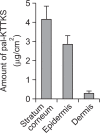Dermal Stability and In Vitro Skin Permeation of Collagen Pentapeptides (KTTKS and palmitoyl-KTTKS)
- PMID: 25143811
- PMCID: PMC4131521
- DOI: 10.4062/biomolther.2014.053
Dermal Stability and In Vitro Skin Permeation of Collagen Pentapeptides (KTTKS and palmitoyl-KTTKS)
Abstract
Collagen pentapeptide (Lys-Thr-Thr-Lys-Ser, KTTKS) and its palmitoylated derivative (pal-KTTKS) have received a great deal of attention as cosmeceutical ingredients for their anti-wrinkle effects. The objective of this study was to evaluate stability and permeability of KTTKS and pal-KTTKS in hairless mouse skin. In this study, a liquid chromatography-tandem mass spectrometric method was developed for the quantification of pal-KTTKS, and used for stability and permeability studies. Stability studies were performed using skin extracts and homogenates. Both KTTKS and pal-KTTKS were rapidly degraded, but pal-KTTKS was more stable than KTTKS. When protease inhibitors were added, the stability of both compounds (KTTKS and pal-KTTKS) improved significantly. In the skin permeation study, neither KTTKS nor pal-KTTKS was detected in the receptor solution, which indicates that neither compound could permeate through the full-thickness hairless mouse skin in the experimental conditions of this study. While KTTKS was not detected in any of the skin layers (the stratum corneum, epidermis, and dermis), pal-KTTKS was observed in all skin layers: 4.2 ± 0.7 μg/cm(2) in the stratum corneum, 2.8 ± 0.5 μg/cm(2) in the epidermis, and 0.3 ± 0.1 μg/cm(2) in the dermis. In conclusion, this study indicated that pal-KTTKS had greater stability and permeability than that of un-modified KTTKS, and may be a useful anti-wrinkle and anti-aging cosmeceutical agent.
Keywords: Collagen pentapeptide; KTTKS; Palmitoyl-KTTKS; Permeability; Stability.
Figures




References
-
- Abu Samah NH, Heard CM. Topically applied KTTKS: a review. Int J Cosmetic Sci. 2011;33:483–490. - PubMed
-
- Aoki K, Kajiwara M, Oka T. The role of bestatin-sensitive aminopeptidase, angiotensin converting enzyme and thiorphan-sensitive “enkephalinase” in the potency of enkephalins in the guinea-pig ileum. Jpn J Pharmacol. 1984;36:59–65. - PubMed
-
- Babu RJ, Kikwai L, Jaiani LT, Kanikkannan N, Armstrong CA, Ansel JC, Singh M. Percutaneous absorption and anti-inflammatory effect of a substance P receptor antagonist: spantide II. Pharm Res. 2004;21:108–113. - PubMed
-
- Benson HAE, Caccetta R, Chen Y, Kearns P, Toth I. Transdermal delivery of a tetrapeptide: evaluation of passive diffusion. Lett Peptide Sci. 2003;10:615–620.
-
- Benson HAE, Namjoshi S. Proteins and peptides: strategies for delivery to and across the skin. J Pharm Sci. 2008;97:3591–3610. - PubMed
LinkOut - more resources
Full Text Sources
Other Literature Sources

